Formula C20H12O5 Melting point 314 °C | Molar mass 332.31 g/mol Classification Fluoresceins | |
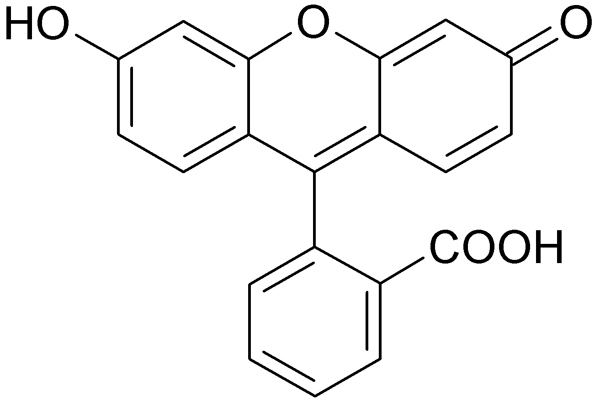 | ||
Pronunciation /fluːˈrɛsiᵻn/ or /fluːˈrɛsiːn/ | ||
Fluorescein is a manufactured organic compound and dye. It is available as a dark orange/red powder slightly soluble in water and alcohol. It is widely used as a fluorescent tracer for many applications.
Contents
- Biochemical research
- Medical use
- Air sea rescue
- River systems
- Oilfield application
- Cosmetics
- Safety
- Chemistry
- Derivatives
- Synthesis
- References

Fluorescein is a fluorophore commonly used in microscopy, in a type of dye laser as the gain medium, in forensics and serology to detect latent blood stains, and in dye tracing. Fluorescein has an absorption maximum at 494 nm and emission maximum of 512 nm (in water). The major derivatives are fluorescein isothiocyanate (FITC) and, in oligonucleotide synthesis, 6-FAM phosphoramidite.
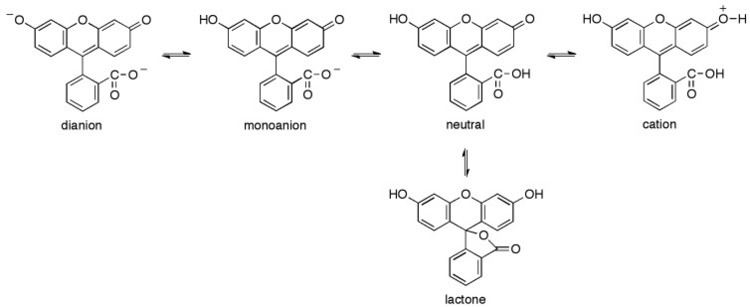
The color of its aqueous solution varies from green to orange as a function of the way it is observed: by reflection or by transmission, as can be noticed in bubble levels, for example; in which fluorescein is added as a colorant to the alcohol filling the tube in order to increase the visibility of the air bubble contained within (thus enhancing the precision of the instrument). More concentrated solutions of fluorescein can even appear red.
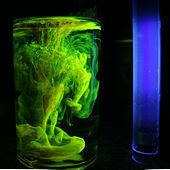
It is on the World Health Organization's List of Essential Medicines, the most important medications needed in a basic health system.
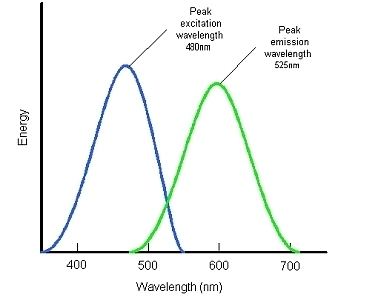
Biochemical research
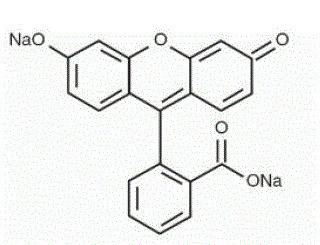
In cellular biology, the isothiocyanate derivative of fluorescein is often used to label and track cells in fluorescence microscopy applications (for example, flow cytometry). Additional biologically active molecules (such as antibodies) may also be attached to fluorescein, allowing biologists to target the fluorophore to specific proteins or structures within cells. This application is common in yeast display.
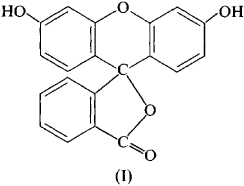
Fluorescein can also be conjugated to nucleoside triphosphates and incorporated into a probe enzymatically for in situ hybridisation. The use of fluorescein amidite shown above allows one to synthesize labeled oligonucleotides for the same purpose. Yet another technique termed molecular beacons makes use of synthetic fluorescein-labeled oligonucleotides. Fluorescein-labelled probes can be imaged using FISH, or targeted by antibodies using immunohistochemistry. The latter is a common alternative to digoxigenin, and the two are used together for labelling two genes in one sample.
Medical use
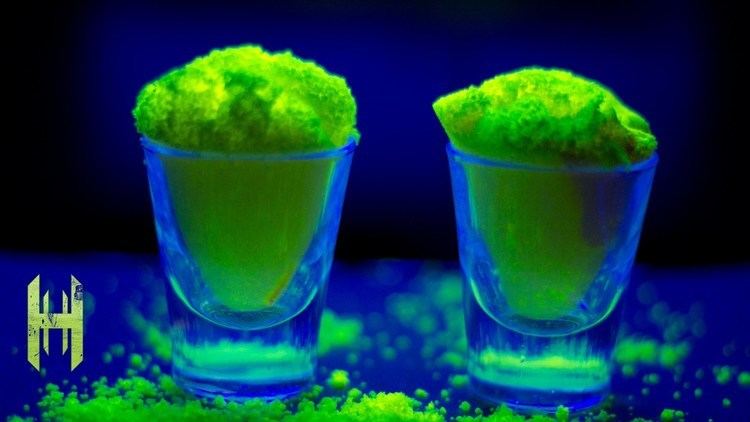
Fluorescein sodium, the sodium salt of fluorescein, is used extensively as a diagnostic tool in the field of ophthalmology and optometry, where topical fluorescein is used in the diagnosis of corneal abrasions, corneal ulcers and herpetic corneal infections. It is also used in rigid gas permeable contact lens fitting to evaluate the tear layer under the lens. It is available as sterile single-use sachets containing lint-free paper applicators soaked in fluorescein sodium.
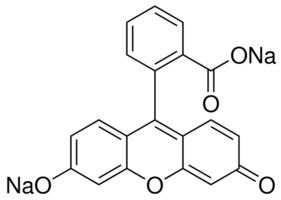
Intravenous or oral fluorescein is used in fluorescein angiography in research and to diagnose and categorize vascular disorders including retinal disease macular degeneration, diabetic retinopathy, inflammatory intraocular conditions, and intraocular tumors. It is also being used increasingly during surgery for brain tumors.

Diluted fluorescein dye has been used to localise multiple muscular ventricular septal defects during open heart surgery and confirm the presence of any residual defects.
Air-sea rescue
During World War II, German aircrew carried small containers of fluorescein. In the event of parachuting into the sea after being shot down, the dye would be released into the water. This produced a vivid marking that could be seen from the air over long distances and aided the air-sea rescue of the downed crew. This was later adopted by other air forces.
River systems
One of its more recognizable uses was in the Chicago River, where fluorescein was the first substance used to dye the river green on St. Patrick's Day in 1962. In 1966, environmentalists forced a change to a vegetable-based dye to protect local wildlife.
Other uses of fluorescein include using it as a water-soluble dye added to rainwater in environmental testing simulations to aid in locating and analyzing any water leaks, and in Australia and New Zealand as a methylated spirit dye.
Oilfield application
Fluorescein dye solutions, typically 15% active, are commonly used as an aid to leak detection during hydrostatic testing of subsea oil and gas pipelines and other subsea infrastructure. Leaks can be detected by divers carrying ultraviolet lights.
Cosmetics
Fluorescein is also known as a color additive (D&C Yellow no. 7). The disodium salt form of fluorescein is known as uranine or D&C Yellow no. 8.
Safety
Topical, oral, and intravenous use of fluorescein can cause adverse reactions, including nausea, vomiting, hives, acute hypotension, anaphylaxis and related anaphylactoid reaction, causing cardiac arrest and sudden death due to anaphylactic shock.
The most common adverse reaction is nausea, due to a difference in the pH from the body and the pH of the sodium fluorescein dye; a number of other factors, however, are considered contributors as well. The nausea usually is transient and subsides quickly. Hives can range from a minor annoyance to severe, and a single dose of antihistamine may give complete relief. Anaphylactic shock and subsequent cardiac arrest and sudden death are very rare, but because they occur within minutes, a health care provider who uses fluorescein should be prepared to perform emergency resuscitation.
Intravenous use has the most reported adverse reactions, including sudden death, but this may reflect greater use rather than greater risk. Both oral and topical uses have been reported to cause anaphylaxis, including one case of anaphylaxis with cardiac arrest (resuscitated) following topical use in an eye drop. Reported rates of adverse reactions vary from 1% to 6%. The higher rates may reflect study populations that include a higher percentage of persons with prior adverse reactions. The risk of an adverse reaction is 25 times higher if the person has had a prior adverse reaction. The risk can be reduced with prior (prophylactic) use of antihistamines and prompt emergency management of any ensuing anaphylaxis. A simple prick test may help to identify persons at greatest risk of adverse reaction.
Chemistry
The fluorescence of this molecule is very intense; peak excitation occurs at 494 nm and peak emission at 521 nm.
Fluorescein has a pKa of 6.4, and its ionization equilibrium leads to pH-dependent absorption and emission over the range of 5 to 9. Also, the fluorescence lifetimes of the protonated and deprotonated forms of fluorescein are approximately 3 and 4 ns, which allows for pH determination from nonintensity based measurements. The lifetimes can be recovered using time-correlated single photon counting or phase-modulation fluorimetry.
Fluorescein has an isosbestic point (equal absorption for all pH values) at 460 nm.
Derivatives
There are many fluorescein derivatives. For example, fluorescein isothiocyanate 1, often abbreviated as FITC, is the original fluorescein molecule functionalized with an isothiocyanate group (-N=C=S), replacing a hydrogen atom on the bottom ring of the structure. This derivative is reactive towards primary amine groups of biologically relevant compounds including intracellular proteins to form a thiourea linkage. A succinimidyl ester functional group attached to the fluorescein core, creating NHS-fluorescein, forms another common amine-reactive derivative, yielding more stable amide adducts. A carboxyl group added to fluorescein makes carboxyfluorescein, and carboxyl, fluorescein, and succinimidyl ester groups compose carboxyfluorescein succinimidyl ester. Pentafluorophenyl esters (PFP) and tetrafluorophenyl esters (TFP) are other useful reagents. In oligonucleotide synthesis, several phosphoramidite reagents containing protected fluorescein, e.g. 6-FAM phosphoramidite 2, are widely used for the preparation of fluorescein-labeled oligonucleotides.
Other green dyes include Oregon Green, Tokyo Green, SNAFL, and carboxynaphthofluorescein. These dyes, along with newer fluorophores such as Alexa 488, FluoProbes 488 and DyLight 488, have been tailored for various chemical and biological applications where higher photostability, different spectral characteristics, or different attachment groups are needed.
The extent to which fluorescein dilaurate is broken down to yield lauric acid can be detected as a measure of pancreatic esterase activity.
Synthesis
Fluorescein was first synthesized by Adolf von Baeyer in 1871. It can be prepared from phthalic anhydride and resorcinol in the presence of zinc chloride via the Friedel-Crafts reaction.
A second method to prepare fluorescein uses methanesulfonic acid as a Brønsted acid catalyst. This route has a high yield under milder conditions.
